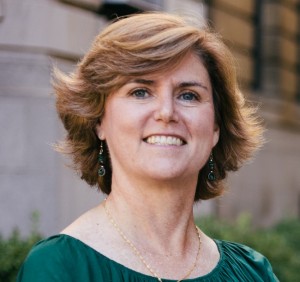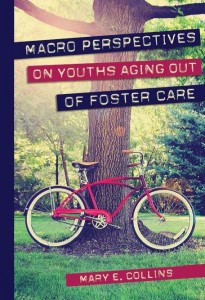Meet the Author: Vulnerable Youth/Child Welfare Policy Expert Mary Collins

Mary Collins, PhD
In her new book Macro Perspectives on Youths Aging Out of Foster Care (published by NASW Press), Mary Collins analyses the legal, social, and environmental obstacles that adolescents leaving care encounter. Focusing on the importance of policy, community, and organizational practice, her book is a must-read for child welfare practitioners, youth researchers, and policymakers.
Dr. Collins talked to SocialWorkersSpeak.Org about how she went from an aspiring police officer to a professor, the importance of engaging in policy processes, and why it’s critical to never give up on disadvantaged youth.
Q. Why did you decide to pursue social work as a profession? Describe your journey in the profession.
Collins: My earliest career aspiration was to be a police officer. Though I completed an undergraduate degree in Criminal Justice, I realized in college that law enforcement was not quite right for me. I was still interested in helping people, so I took a job working in a short-term shelter for teen runaways, status offenders, and those in the child welfare system who were in between placements. While working at the shelter I was mentored by an older colleague. She suggested that I pursue graduate work. I remain grateful for her career guidance at that point in my life – it was instrumental. I was accepted to University of Chicago’s School of Social Service Administration. Although I never considered earning a Ph.D. or pursuing an academic career, I had the opportunity to work on research projects that impacted my scholarly trajectory. My focus ever since has been policy and research regarding children, youth, and families.
Q. What inspired you to write Macro Perspectives on Youths Aging Out of Foster Care? Why is taking a macro perspective so important for this topic?
Collins: My experience with the adolescents in the short-term shelter provided substantial insight into the range of challenges they face, particularly when their relationships with parents and other key adults are compromised. Later in my career, while conducting evaluations for an agency with residential programming, I was stunned to learn about the very minimal supports these young people were receiving after they left group care for independent living. That began my committed interest to the “aging out” population.
Though excellent work has been done to understand the developmental trajectory, attachment issues, and clinical perspectives of aging out youth, I feel a macro perspective is particularly needed at this point in time. My book aims to fill this gap and provide more emphasis on the larger systems issues. I work from a policy and systems perspective rather than a micro or clinical view.
Q. Why do you think the needs of this population have historically been ignored?

Collins: There are several reasons. As a society, we have a more protective and warm response to children, at least in principle if not always in practice. From a policy perspective, adolescents are often ignored unless they’re identified as a “problem” to control – i.e. juvenile delinquents, teen parents, high school dropouts, or drug addicts. Even within child welfare systems, which are responsible for all minors (those under 18) in their care, far more focus goes to young children than to adolescents. Additionally, child welfare systems may be reluctant to extend supports to young adults because doing so would add to both their mission and their costs. In contrast, directing resources to young children, reunifying and strengthening families, or moving children into adoptive homes removes cases from the system.
In the book, I suggest that as vulnerable, abused children become troubled adolescents with poor social outcomes, their social construction changes from primarily positive to primarily negative. The importance of the developmental process in the young adult years is seldom recognized in U.S. society. Unfortunately, the increasing difficulty for all young people to achieve markers of adulthood – particularly steady employment – is only worse for those with histories of disadvantage.
Q. Has there been a particular adolescent in this population that has stuck with you throughout your career?
Collins: Rather than one particular person, I think often of the range of adolescents I worked with, interviewed, or hired on my projects. Even back when I worked in the shelter for teen girls, prior to my MSW training, I made a conscious effort to remember the young people I encountered there. I still reflect back about what I learned from them all those years ago. For example, we had more than a few teens who were resistant to the programming and some who ran from the facility. Some who displayed the most challenging behaviors early ended up in quite positive circumstances. Unfortunately, sometimes the reverse also occurred. So not giving up on these young people, and not allowing others to give up on them, is critical.
Q. What are some of common challenges/frustrations that social workers serving this population face? How do you suggest these challenges be overcome?
Collins: Some social workers are particularly skilled in working with adolescents and young adults. They frequently see the population of aging out youth as smart, engaging, and thoughtful young people trying their best to battle the odds against them. One frustration I hear is that social workers are constantly fighting against societal stereotypes of young people. It can be difficult for social workers to find people and places that will give adolescents a chance and provide the support to help them succeed. Strong advocacy is a primary mechanism to overcome these challenges. Often, the advocacy occurs internal to the agency – helping the young person to remain in care or secure resources. If there were more opportunities (such as good housing options or vocational training slots) then workers would not have to fight so hard to help their youth get access. Another suggestion is for increased collaborative action among those working with this population. It may be more effective, and certainly less isolating, to work as an organized group to secure resources for the population.
Q. The concluding section of your book is entitled “Furthering best practice.” What are some of the core areas of macro practice relevant to youth leaving care?
Collins: Policy practice, organizational practice, and community practice are three core areas that I address. In terms of policy
practice, one of the lessons is to understand how this population fits within our overall policy frameworks. The adolescents are a marginalized population in the marginalized policy arena of child welfare. This has implications for potential policy reforms. Linking the needs of this group with other youth populations – the term “disconnected” youth is often used – may provide more traction in policy environments.
In terms of organizational practice, I provide particular focus on workforce issues and program evaluation. The public child welfare agencies need a workforce that is knowledgeable about the specific adolescent development issues as well as appropriate resources. On a personal level, they also must like adolescents and young adults. It’s also important to recognize that program evaluation is frequently underutilized by the public agencies and their contracted partners. It’s stunning that we continually offer services without a commitment to developing an evidence base. We would never allow that for medical interventions, so why do we allow it for social work interventions?
Finally, community practice is especially relevant to the aging out population. As they leave the care of the public child welfare agency, it is critical to ensure that they are well situated in, and connected to, multiple communities. A skilled workforce and appropriate policy supports can help this to occur.
Q. What do you hope readers that will take away from your book?
Collins: The larger environmental context matters greatly to the prospects for these young people. Strong families and communities help most of us achieve a measure of success in adulthood. Because these young people often lack these supports, they are particularly vulnerable to societal forces. Weak job markets and tight housing markets cause huge challenges. Our systems of higher education, health care, and social welfare are critically important. The dismantling of the social welfare safety net damages the prospects for these, and many other, vulnerable populations. While we need particular investments in the aging out population, we also need to bolster our social welfare systems across the board. Small scale, individually-oriented assistance will not be enough. A far more robust commitment is needed.
Q. What advice would you give to those entering social work or related professions?
Collins: For all types of direct practice, humility is key. Be open to working with different populations, in different settings, with different challenges and strengths. Listen and learn from the people that you work with. This will help you make the connection that is so critical to the work.
Engaging in macro settings and policy processes is an important aspect of social work. To me, it is apparent that more resources need to be devoted to those who have little. Youth who are aging out of care are a perfect example of this. But many other populations are also highly disadvantaged and require large scale sustained assistance. I have found, particularly among my students, that there can be reluctance to engage in policy practice. But with just a bit of support and training, social workers quickly become skilled and effective in these activities.
Macro Perspectives on Youths Aging Out of Foster Care is available for an Early Bird discount until November 15. For more information about publishing with NASW Press, please contact Stella Donovan, Acquisitions Editor, at sdonovan@naswdc.org.
Mary Collins, PhD, is associate dean for academic affairs, chair of social welfare policy, and professor at the Boston University School of Social Work.
| Leave A CommentAdvertisement
1 Comment
Leave a Comment
You must be logged in to post a comment.



I just wanted to underscore the quote, “There are several reasons. As a society, we have a more protective and warm response to children, at least in principle if not always in practice. From a policy perspective, adolescents are often ignored unless they’re identified as a ‘problem’ to control.” That is such an important point for everyone, regardless of whether they work directly with youth or not to be aware of. I have worked in child welfare for four years, specifically with youth for the past year, a position that I went into child welfare to do. I have come to hear myself say over and over that the vulnerability we measure can not be viewed the same in a child who is two and a child who is 16. I think if we continue to view vulnerability on a continuum our most vulnerable youth will continue to slip through the cracks. I appreciate that Dr. Collins has written this very important book!